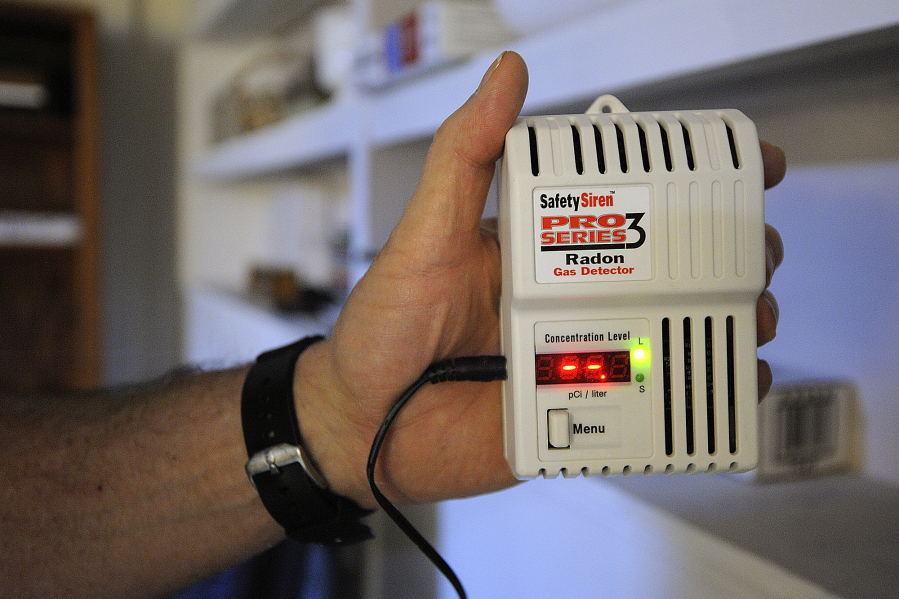Work is underway at two Evergreen school district campuses to mitigate elevated levels of radon found in two rooms.
The district announced last week that it had discovered radon rates of 11.1 picocuries per liter of air in the gym at Sifton Elementary School, and rates of 4.2 picocuries per liter of air in a classroom at Marrion Elementary School.
The Environmental Protection Agency recommends mitigation efforts above 4 picocuries per liter of air. Anything above that is unsafe for continual exposure to the toxic gas released from the natural decay of uranium, which is present in granite. Radon is the second-leading cause of lung cancer.
Elevated levels were found in other rooms at Sifton as well as at Orchards Elementary School and Crestline Elementary School, though district officials say they’ve already taken steps to reduce those levels back to safe amounts.
District spokeswoman Gail Spolar said the district will be testing 11 schools in the southern part of the district over the next two weeks, then stop over spring break before finishing testing at the rest of the district campuses afterward. Testing must be done when the building is open in order to show the radon content present under typical use.
Those southern schools tend to be more at risk of elevated radon levels because they’re close to clusters of granite, which has a high uranium content.
“That’s where you’re closer to those gravel beds,” Spolar said.
The district will provide information to students, parents and staff as test results from the district’s contractor, Cascade Radon, are returned.
“We’re going to be really transparent about this, pushing the results out and letting folks know,” Spolar said.
Other districts
Radon testing is not required by federal or state law, which means different school districts set different policies for how frequently to test. The same is true for lead testing. Local districts made headlines last year after several schools tested positive for lead in some drinking water sources.
Vancouver Public Schools last conducted radon testing in 2013 and all its campuses came back within safe ranges, spokeswoman Pat Nuzzo said. The district does testing every five years, which means it will do another round of testing in 2018.
Battle Ground Public Schools last tested for radon in the 2010-2011 school year, and found no schools above the EPA’s acceptable limits, spokeswoman Rita Sanders said.
The Washougal School District last tested for radon in 2012. District Facilities Director Joe Steinbrenner said the district tests for radon anytime a structural change is made to a building.
The district is constructing two new schools with a shared campus, Columbia River Gorge Elementary School and Jemtegaard Middle School. They’re expected to open in the fall. Steinbrenner said the new school will have a radon mitigation system in place when the school opens.
“It’s a lot less expensive to put it in during construction than after,” he said.
Home testing
Cascade Radon President Annie Tucker, whose company is doing testing and mitigation work at Evergreen, stressed the importance of testing for radon and taking steps to keep its levels low.
“When you look at Clark County, it has the unique distinction of being the only place in the Northwest that was on the original EPA radon map as a No. 1 risk spot,” she said.
In the cases of most of the rooms at Evergreen Public Schools campuses, reducing radon levels can be as simple as making sure air vents are fully opened, that posters aren’t covering vents, or moving temporary walls to improve air flow. But some spaces, especially larger buildings like schools, can require more intensive work to mitigate radon.
Though Tucker couldn’t speak specifically to what work Sifton and Marrion will need, she said larger buildings with multiple inputs to their ventilation systems could require more work to determine the cause of higher radon levels.
“We’re following proper standards and protocols and we’re trying to approach this from the most cost-effective way,” she said. “We will get the levels down, we’re confident in that.”
Using electronic testing equipment, Cascade Radon is able to tell how much of the toxic gas is in the air within 48 hours. Most home kits, however, are charcoal systems that cost between $15 and $25. After conducting the test, homeowners send the test kit to a lab for review. There is also long-term testing homeowners can do over the course of months or a year.
“I think the most important thing is people need to understand that they need to be testing their own homes,” Tucker said. “Being in a high-risk area, this is a good wake-up call.”
Adam Littman of The Columbian contributed to this report.





